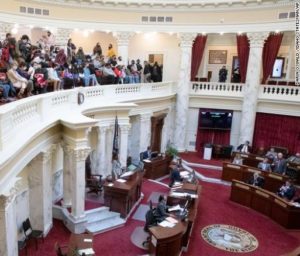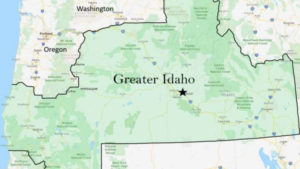 Idaho legislators are “intrigued but skeptical” about a scheme “to lop off about three-fourths of Oregon,” plus some northern California counties, and add those areas to Idaho to create “the nation’s third-largest state” by moving existing state boundaries, a Los Angeles TV station reported. (Read story here, and see map below).
Idaho legislators are “intrigued but skeptical” about a scheme “to lop off about three-fourths of Oregon,” plus some northern California counties, and add those areas to Idaho to create “the nation’s third-largest state” by moving existing state boundaries, a Los Angeles TV station reported. (Read story here, and see map below).
This has been making news since last year, when an advisory vote was taken, and is back in the news because of an initiative on ballots in five Oregon counties next month. The idea is that eastern Oregon’s rural counties are more politically aligned with conservative Idaho than Oregon’s more-liberal urban areas. The movement’s founder and leader puts it this way: “Oregon is a powder keg because counties that belong in a red-state like Idaho are ruled by Portlanders.”
He also claims rural areas are “underrepresented in Congress,” which isn’t true; rural voters have an outsized say in Congress, state legislatures, and the electoral college. What is true, though, is Republican-leaning rural voters are frustrated by being outvoted by cities, where America’s population is concentrated. In Washington, for example, the rural eastern portion of the state compromises about two-thirds of the state’s land area, but has only a fifth of the population, and state politics are dominated by more liberal-leaning Puget Sound-area voters, where well over half the state’s population live.
State boundaries were drawn at a time when most Americans lived on farms, and creation of new states was driven by slavery politics. Since then, not only has the bulk of America’s population migrated to cities, but more recently, U.S. politics has increasingly divided along urban-rural lines. So a credible argument can be made that state boundaries are out-of-date.
But MSN notes that, “Even if each county votes to pass the initiative redrawing state lines would require input from state and federal officials, where it’s highly unlikely the measure would move forward.” (Read that story here.) That’s because admitting new states, splitting up existing states, or shifting state boundaries is the exclusive purview of Congress. Thus the initiative, if passed by voters, will be an expression of local sentiment, but can have no legal force or effect.
One wonders whether the promoters and supporters of this idea know that?
Related story: Idaho legislators vote to censor teaching in public schools and colleges. Read story here.
Photo: The Idaho legislature in session

One wonders when or if Maryland is going to ok the District of Columbia becoming a state. Only in the case of Maine has a state voluntarily given up territory for a new state. West Virginia got statehood during the civil war, so one could argue it is a direct result of slavery.
Idaho becoming a state has nothing to do with slavery. The same is true of Washington. Now Oregon formed in 1859 actually reeks of slavery’s involvement. It entered the Union as a freed state, but freed slaves were not to enter the state and those there wereto be expelled. It is an odd fact Oregon’s first two Senators were pro slavery Democrats, that did not last long.
I agree that this is a pipedream along with Cascadia or a state being made out of Eastern Washington, though that would make the admission of Puerto Rico or DC more probable.
D.C. is not part of any state. Maryland ceded it to the federal government in 1790. It’s under Congress’s exclusive jurisdiction. Therefore, Congress is free to make it a state, and Maryland’s “permission” isn’t a prerequisite.